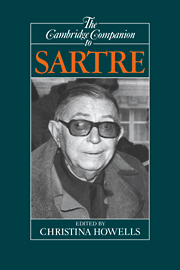Book contents
- Frontmatter
- Introduction
- Part I Phenomenology and existentialism
- Part II Psychology and ethics
- Part III History and structure
- 7 Sartre and the poetics of history
- 8 Sartre on progress
- 9 Sartrean Structuralism?
- Conclusion: Sartre and the deconstruction of the subject
- Appendix; Hegel and Sartre
- Bibliography
- Index
9 - Sartrean Structuralism?
from Part III - History and structure
Published online by Cambridge University Press: 28 May 2006
- Frontmatter
- Introduction
- Part I Phenomenology and existentialism
- Part II Psychology and ethics
- Part III History and structure
- 7 Sartre and the poetics of history
- 8 Sartre on progress
- 9 Sartrean Structuralism?
- Conclusion: Sartre and the deconstruction of the subject
- Appendix; Hegel and Sartre
- Bibliography
- Index
Summary
THE CURVE OF THE EPOCH
By the time of Sartre's death in 1980, Structuralism, as a movement, had evaporated, and various forms of Post-Structuralism were in full swing. At the beginning of his career, in the 1920s and 1930s, Structuralism was just beginning to be thought of, in a few localities remote from Paris and existentialism in disciplinary and in geographical space - for example technical linguistics in Prague. There is a sense, then, in which Sartre's life and that of Structuralism run in parallel, a tempting observation enough in the light of his theory of oracular lives, of the “curves” of epochs, in the third volume of L'Idiot de la famille. The conjecture that Sartre and Structuralism might have had a serious affinity seems at first glance however to be a nonstarter, given the lack of apparent overlap between his concerns and those of the major structuralists (whether by avowal or attribution): Althusser, Barthes, Dumézil, Foucault, Lacan, Lévi-Strauss.
What the structuralists had in common was a preoccupation with embodied relationships - whether political, literary, religious, historical, psychoanalytic, or ethnological - taken to be objective, sharing or borrowing the structure of language, and reflecting the unconscious structure of mind. What Sartre emphasized, in contrast, was the complete lucidity of the conscious subject as free to enter or not into relationships, and the responsibility of the agent for the constitution and maintenance in practice of the group structures to which he or she might belong.
- Type
- Chapter
- Information
- The Cambridge Companion to Sartre , pp. 293 - 317Publisher: Cambridge University PressPrint publication year: 1992
- 6
- Cited by



